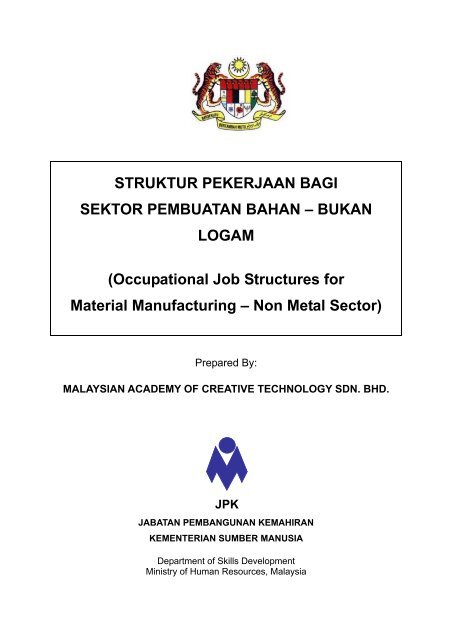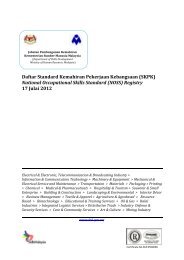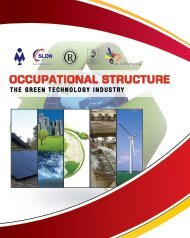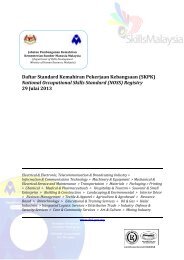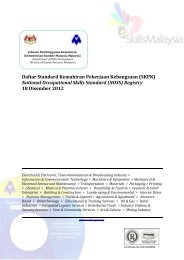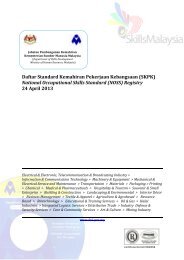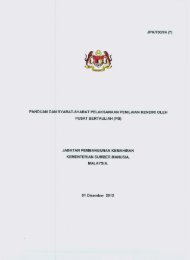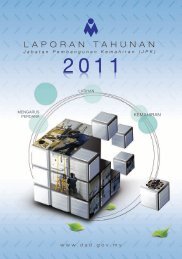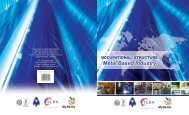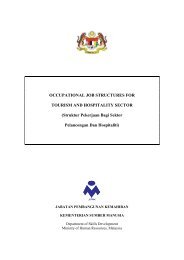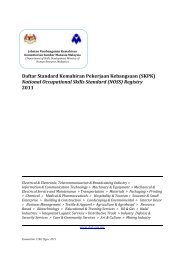Material Manufacturing - Non metal.pdf - JPK
Material Manufacturing - Non metal.pdf - JPK
Material Manufacturing - Non metal.pdf - JPK
Create successful ePaper yourself
Turn your PDF publications into a flip-book with our unique Google optimized e-Paper software.
STRUKTUR PEKERJAAN BAGI<br />
SEKTOR PEMBUATAN BAHAN – BUKAN<br />
LOGAM<br />
(Occupational Job Structures for<br />
<strong>Material</strong> <strong>Manufacturing</strong> – <strong>Non</strong> Metal Sector)<br />
Prepared By:<br />
MALAYSIAN ACADEMY OF CREATIVE TECHNOLOGY SDN. BHD.<br />
<strong>JPK</strong><br />
JABATAN PEMBANGUNAN KEMAHIRAN<br />
KEMENTERIAN SUMBER MANUSIA<br />
Department of Skills Development<br />
Ministry of Human Resources, Malaysia
TABLE OF CONTENTS<br />
1. LIST OF PANEL AND FACILITATOR<br />
2. LIST OF FIGURE<br />
3. LIST OF TABLE<br />
4. LIST OF ADDENDUM<br />
5. EXECUTIVE SUMMARY<br />
TITLE PAGE<br />
6. CONCEPT AND STRUCTURE OF MALAYSIAN SKILL<br />
CERTIFICATION SYSTEM<br />
7. INTRODUCTION AND BACKGROUND OF THE<br />
MATERIAL MANUFACTURING – NON METAL SECTOR<br />
8. METHODOLOGY OF OCCUPATIONAL ANALYSIS<br />
9. FINDINGS<br />
10. REFERENCES<br />
ADDENDUM<br />
3<br />
5<br />
5<br />
5<br />
6<br />
7<br />
8<br />
15<br />
17<br />
20<br />
2
1. LIST OF PANEL AND FACILITATOR<br />
PANEL<br />
List of Panel Expert for the Development of Occupational Analysis for <strong>Material</strong><br />
<strong>Manufacturing</strong> – <strong>Non</strong> Metal Sector<br />
NO. NAME<br />
1. Khudairi Abu Sari<br />
2. Mazidah bt Hasbullah<br />
3. Mohd Harizan Rasip<br />
4. Mohd Zain Abdul Aziz<br />
5. Mohd Fairus Ahmad<br />
6. Zuhide Ramli<br />
DESIGNATION &<br />
COMPANY<br />
R&D and Production<br />
Manager<br />
Rohas Composites<br />
Manager<br />
Mass Composite<br />
Technology Sdn. Bhd.<br />
QA Manager<br />
Rohas Composites<br />
Managing Director/<br />
Principle Consultant<br />
Multi Skills Training<br />
Consultancy Sdn. Bhd.<br />
Consultant<br />
Multi Skills Training<br />
Consultancy Sdn. Bhd.<br />
Production Manager<br />
Labplus Sdn. Bhd.<br />
SUB SECTOR EXPERTISE<br />
Composite<br />
Composite<br />
Composite<br />
Composite<br />
Composite<br />
Polymer<br />
• Production<br />
• Engineering<br />
Services<br />
• Quality<br />
Assurance<br />
• <strong>Material</strong>s<br />
Procurement<br />
• Production<br />
• Engineering<br />
Services<br />
• <strong>Material</strong>s<br />
Procurement<br />
• Production<br />
• Engineering<br />
Services<br />
• Quality<br />
Assurance<br />
• <strong>Material</strong>s<br />
Procurement<br />
• Production<br />
• Engineering<br />
Services<br />
• Quality<br />
Assurance<br />
• Maintenance<br />
• Production<br />
• Engineering<br />
Services<br />
• Quality<br />
Assurance<br />
• Maintenance<br />
• Production<br />
• Engineering<br />
Services<br />
• Quality<br />
Assurance<br />
• Maintenance<br />
3
7. Wira Jaafar<br />
8. Yusoff Mohamed hani<br />
9. Mohd Hafizi Nordin<br />
10. Saidin Karim<br />
11. Doll Said Ngah<br />
Manager<br />
Labplus Sdn. Bhd.<br />
Production Executive<br />
Jebco Sdn. Bhd.<br />
Researcher<br />
Plastics Technology<br />
Group<br />
SIRIM<br />
Senior Researcher<br />
Pusat Teknologi Seramik,<br />
SIRIM<br />
Senior Researcher<br />
Pusat Teknologi Seramik,<br />
SIRIM<br />
12. Ali Sabri Salahuddin Manager<br />
Johan Ceramics Berhad<br />
FACILITATOR<br />
1. Ahmad Ramdan M Yusof<br />
Polymer<br />
Polymer<br />
Polymer<br />
Ceramics &<br />
Glass<br />
Ceramics &<br />
Glass<br />
Ceramics &<br />
Glass<br />
• Production<br />
• Engineering<br />
Services<br />
• Quality<br />
Assurance<br />
• Production<br />
• Engineering<br />
Services<br />
• Quality<br />
Assurance<br />
• Maintenance<br />
• Production<br />
• Engineering<br />
Services<br />
• Quality<br />
Assurance<br />
• Maintenance<br />
• <strong>Material</strong>s<br />
Processing<br />
• Production<br />
• Finishing<br />
• R&D<br />
• Quality<br />
Assurance<br />
• <strong>Material</strong>s<br />
Processing<br />
• Production<br />
• Finishing<br />
• R&D<br />
• Quality<br />
Assurance<br />
• <strong>Material</strong>s<br />
Processing<br />
• Production<br />
• Finishing<br />
• R&D<br />
• Quality<br />
Assurance<br />
• Maintenance<br />
Malaysian Academy of Creative<br />
Technology Sdn. Bhd. (MACiT)<br />
4
2. LIST OF FIGURE<br />
Figure 1: Concept and Structure of Malaysian Skills Certification<br />
3. LIST OF TABLE<br />
Table 1: Structure of <strong>Material</strong> <strong>Manufacturing</strong> – <strong>Non</strong> Metal Sector<br />
Table 2: Examples of Job Title and Hierarchy<br />
Table 3: Critical and <strong>Non</strong> Critical Job Title<br />
4. LIST OF ADDENDUM<br />
Addendum 1: Job Area in <strong>Material</strong> <strong>Manufacturing</strong> – <strong>Non</strong> Metal Sector<br />
Addendum 2: Job Titles and Hierarchy in <strong>Material</strong> <strong>Manufacturing</strong> – <strong>Non</strong><br />
Metal Sector<br />
Addendum 3: Occupational Definition in <strong>Material</strong> <strong>Manufacturing</strong> – <strong>Non</strong><br />
Metal Sector<br />
Addendum 4: Critical & <strong>Non</strong> Critical Job for <strong>Material</strong> <strong>Manufacturing</strong> – <strong>Non</strong><br />
Metal Sector<br />
5
5. EXECUTIVE SUMMARY<br />
Recognizing the importance of skilled human resource, the Department of Skills<br />
Development, Ministry of Human Resource, Malaysia has requested an<br />
Occupational Analysis to be carried out on the <strong>Material</strong> <strong>Manufacturing</strong> – <strong>Non</strong><br />
Metal sector to evaluate the requirement of skilled manpower in this sector.<br />
For this Occupational Analysis, <strong>Material</strong> <strong>Manufacturing</strong> – <strong>Non</strong> Metal sector can<br />
be defined as the whole material manufacturing industry, which not relating to<br />
<strong>metal</strong> and other products manufacturing. However, this analysis only focusing<br />
on Ceramic & Glass, Polymer and Composite sub sector.<br />
In conducting the Occupational Analysis on the <strong>Material</strong> <strong>Manufacturing</strong> – <strong>Non</strong><br />
Metal sector, information on the material manufacturing industry was gathered<br />
through literature search, interviews and discussions with the industry experts<br />
and players from the industry. Visits to establishments and related public<br />
departments were also carried out. A workshop was held in an attempt to get<br />
better understanding on the sub sector structure, job titles and hierarchy, and the<br />
activities of the said sub sector.<br />
The occupational analysis conducted on the <strong>Material</strong> <strong>Manufacturing</strong> – <strong>Non</strong><br />
Metal sector has led the team to identify 10 job areas under 4 sub sectors. These<br />
job areas cover 140 job titles identified in this sector. The hierarchy of each job<br />
title is identified and their definition is well defined by the panels.<br />
6
6. CONCEPT AND STRUCTURE OF MALAYSIAN SKILL<br />
CERTIFICATION SYSTEM<br />
6.1 National Occupational Skills Standard (NOSS)<br />
NOSS is defined as a specification of the competencies expected of a<br />
skilled worker who is gainfully employed in Malaysia for an occupational<br />
area and level.<br />
6.2 Concept and Structure of Malaysian Skills Certification<br />
Type of Skill Certification<br />
MTM Level 8: - Senior Maister Technologist<br />
(Malaysian Maister Technologist)<br />
Mastery over range of skills and knowledge in developing an original understanding and<br />
extend an area of knowledge or professional practice. It reflects the ability to address<br />
situation that involved highest level of complex judgement, highly varied and/ or<br />
specialised major functions, and interacting factors through initiating, designing and<br />
undertaking research, planning and development of strategic activities. It involved the<br />
exercise of broad autonomy, judgement and leadership for the development of a field of<br />
work or knowledge or for creating substantial<br />
professional or organisational change. It also reflects a critical understanding of relevant<br />
theoretical and methodological perspectives and how they affect the field of knowledge or<br />
works.<br />
MKM Level 7: - Maister Technologist<br />
(Malaysian Skills Maister)<br />
Mastery of broad and/ or specialised skills in reformulating and use relevant approaches<br />
to address highly varied and/ or specialized situations that involve many interacting<br />
factors. It includes taking responsibility, understanding, methodologies for planning and<br />
developing courses of action that initiate or underpin substantial change or development,<br />
as well as exercising broad autonomy and judgments. It also reflects an understanding of<br />
theoretical and relevant methodological perspectives, and how they affect their area of<br />
study or work.<br />
TKM Level 6 - Management Level<br />
(Malaysian Skills Technologist)<br />
Competent in applying a significant range of complex principles and techniques across a<br />
wide and often unpredictable variety of contexts. It reflects the ability to refine and use<br />
relevant understanding, methods and skills to address complex problems that have<br />
limited definition, includes taking responsibility for planning and developing courses of<br />
action that are able to underpin substantial change or development, as well as exercising<br />
broad autonomy and judgment. It also reflects an understanding of different perspectives,<br />
approaches of schools of thought and the theories that underpin them.<br />
SKM Level 5 - Management Level<br />
(Diploma/Advance Diploma Technology)<br />
‘Competent in applying a significant range of fundamental principles and complex<br />
techniques across a wide and often unpredictable variety of contexts. Very substantial<br />
personal autonomy and often significant responsibility for the work of others and for the<br />
allocation of substantial resources feature strongly, as do personal accountabilities for<br />
analysis and diagnosis, design, planning, execution and evaluation.’<br />
SKM Level 4 - Supervisory Level<br />
(Diploma/Diploma Technology)<br />
‘Competent in performing a broad range of complex technical or professional work<br />
activities performed in a wide variety of contexts and with a substantial degree of<br />
personal responsibility and autonomy. Responsibility for the work of others and<br />
allocation of resources is often present.’<br />
SKM Level 3 - Supervisory Level<br />
(Malaysian Skill Certificate)<br />
‘Competent in performing a broad range of varied work activities, performed in a<br />
variety of context, most of which are complex and non-routine. Considerable<br />
responsibility and autonomy and control or guidance of others is often required.’<br />
SKM Level 2 - Operation and Production Level<br />
(Malaysian Skill Certificate)<br />
‘Competent in performing a significant range of varied work activities, performed in a<br />
variety of context. Some of the activities are non-routine and required individual<br />
responsibility and autonomy.’<br />
SKM Level 1 - Operation and Production Level<br />
(Malaysian Skill Certificate)<br />
‘Competent in performing a range of varied work activities, most of which are routine<br />
and predictable.’<br />
Figure 1: Concept and Structure of Malaysian Skills Certification<br />
7
7. INTRODUCTION AND BACKGROUND OF THE MATERIAL<br />
MANUFACTURING – NON METAL SECTOR<br />
The definition of material production/manufacturing is the activity to change the<br />
natural resources into commodity the use of human labour, skills, and<br />
productive forces.<br />
<strong>Material</strong> <strong>Manufacturing</strong> – <strong>Non</strong> Metal sector can be defined as the whole<br />
material manufacturing industry, which not relating to <strong>metal</strong> and other products<br />
manufacturing. <strong>Material</strong> <strong>Manufacturing</strong> – <strong>Non</strong> Metal Sector is inclusive of<br />
wood, rubber, palm oil, water, ceramics & glass, polymer, composite, chemical<br />
and concrete. However, wood, rubber, palm oil, water, chemical and concrete<br />
are already defined in Resource Based, Chemical and Building & Construction<br />
Sector.<br />
The structure of <strong>Material</strong> <strong>Manufacturing</strong> – <strong>Non</strong> Metal Sector can be seen in the<br />
Table 1 below:<br />
Table 1: Structure of <strong>Material</strong> <strong>Manufacturing</strong> – <strong>Non</strong> Metal Sector<br />
Resource Based<br />
Wood Rubber Palm<br />
Oil<br />
Water Ceramics<br />
& Glass<br />
Other <strong>Non</strong> Metal <strong>Material</strong><br />
<strong>Manufacturing</strong><br />
Polymer Composite<br />
Chemical<br />
Instrumentation<br />
(Oil & Gas)<br />
For this Occupational Analysis, the focus area is on Ceramic & Glass, Polymer<br />
and Composite.<br />
7.1 Ceramics & Glass<br />
Building<br />
Construction<br />
Concrete<br />
The word ceramic can be traced back to Greek term keramos, meaning<br />
‘burned stuff’. Ceramics can be defined as inorganic, non-<strong>metal</strong>lic<br />
materials that are typically produced by heating or firing clays and other<br />
minerals from the earth or chemically processed powders. This definition<br />
includes not only materials such as pottery, porcelain, refractories,<br />
structural clay products, abrasives, porcelain, enamels and glass but also<br />
non-<strong>metal</strong>lic magnetic materials, ferroelectrics, glass ceramics and a<br />
8
variety of other products which were not in existence until a few years ago<br />
and many which do not exist today.<br />
Ceramics can be divided into two classes: traditional and advanced.<br />
Traditional ceramics include clay products and silicate glass while<br />
advanced ceramics consist of carbides (SiC), pure oxides (Al2O3),<br />
nitrides (Si3N4), non-silicate glasses and many others.<br />
7.2 Polymer<br />
Polymer is any of numerous natural and synthetic compounds of usually<br />
high molecular weight consisting of up to millions of repeated linked<br />
units, each a relatively light and simple molecule.<br />
There are three general groups of polymer materials, which are<br />
Thermoset, Elastomer and Thermoplastic.<br />
i. Thermoset<br />
Thermoset are polymers which do not melt when heated.<br />
Thermosets molecules are cross-linked by strong covalent<br />
intermolecular bonds, forming one giant molecule. Cross-linking is<br />
achieved in curing process initiated by heat, chemical agents or<br />
radiation. Before curing processing thermoset materials are stored in<br />
partially polymerized condition. Thermosets are stronger and stiffer<br />
than thermoplastics.<br />
Common thermosets are:<br />
• Epoxies (EP)<br />
• Unsaturated Polyesters (UP)<br />
• Phenolics (PF)<br />
• Urea Formaldehyde (UF)<br />
• Melamine Formaldehyde (MF)<br />
• Alkyds<br />
9
ii. Elastomer<br />
Elastomers are polymers possessing high elasticity - may be<br />
reversibly stretched at high degree. Elastomers consists of long<br />
lightly cross-linked molecules.<br />
Common elastomers are:<br />
• Polyisoprene (natural rubber)<br />
• Butyl<br />
• Nitrile<br />
• Neoprene<br />
• Ethylene-Propylene<br />
• Hypalon<br />
• Silicone<br />
Elastomer may be strengthened by vulcanization process (heat<br />
treatment in presence of chemical agents). Vulcanization results in<br />
increase of cross-linking of the molecules. Vulcanized elastomers<br />
are elastic for small deformations.<br />
iii. Thermoplastic<br />
Thermoplastics are polymers, which soften (becomes pliable and<br />
plastic) and melt when heated. In the melted conditions<br />
thermoplastics may be formed by various methods (injection<br />
molding, extrusion, Thermoforming).<br />
No new cross-links form (no chemical curing) when a thermoplastic<br />
cools and harden. Thermoplastics may be reprocessed (re-melt)<br />
many times.<br />
Common thermoplastics are:<br />
• Thermoplastic Low Density Polyethylene (LDPE)<br />
• Thermoplastic High Density Polyethylene (HDPE)<br />
• Polypropylene (PP)<br />
• Acrylonitrile-Butadiene-Styrene (ABS)<br />
• Polyvinyl Chloride (PVC)<br />
10
7.3 Composite<br />
• Polymethylmethacrylate (PMMA)<br />
• Polytetrafluoroethylene (PTFE)<br />
• Polyethylene Terephtalate (PET)<br />
• Nylon<br />
• Polyimide (PI)<br />
• Polycarbonate (PC)<br />
• Polysulfone (PSF)<br />
A composite material is made by combining two or more materials to give<br />
a unique combination of properties. The above definition is more general<br />
and can include <strong>metal</strong>s alloys, plastic co-polymers, minerals, and wood.<br />
Fiber-reinforced composite materials differ from the above materials in<br />
that the constituent materials are different at the molecular level and are<br />
mechanically separable. In bulk form, the constituent materials work<br />
together but remain in their original forms. The final properties of<br />
composite materials are better than constituent material properties. The<br />
main concept of a composite is that it contains matrix materials. Typically,<br />
composite material is formed by reinforcing fibers in a matrix resin. The<br />
reinforcements can be fibers, particulates, or whiskers, and the matrix<br />
materials can be <strong>metal</strong>s, plastics, or ceramics. The reinforcements can be<br />
made from polymers, ceramics, and <strong>metal</strong>s. The fibers can be continuous,<br />
long, or short. Composites made with a polymer matrix have become more<br />
common and are widely used in various industries.<br />
Spray up, blow, injection and compression moulding utilize short fibres,<br />
whereas filament winding, pultrusion, resin transfer moulding, hand layup,<br />
autoclave moulding and roll wrapping use continuous fibres. Polymericbased<br />
composite materials have become common engineering materials<br />
and are designed and manufactured for various applications including<br />
automotive components, sporting goods, aerospace parts, consumer goods,<br />
and in the marine and oil industries.<br />
11
Typically, most common composite materials, including fiberglass, carbon<br />
fiber, and kevlar, include at least two parts, including the resin. Polyester<br />
resin, tends to have yellowish tint, and is suitable for most backyard<br />
projects. Its weaknesses are that it is UV sensitive and can tend to degrade<br />
over time, and thus generally is also coated to help preserve it. It is often<br />
used in the making of surfboards and for marine applications.<br />
Vinylester resin, tends to have a purplish to bluish to greenish tint. This<br />
resin has lower viscosity than polyester resin, and is more transparent. This<br />
resin is often billed as being fuel resistant, but will melt in contact with<br />
gasoline. This resin tends to be more resistant over time to degradation<br />
than polyester resin, and is more flexible. It uses the same hardener as<br />
polyester resin (at the same mix ratio) and the cost is about the same.<br />
Epoxy resin is almost totally transparent when cured. In the aerospace<br />
industry, epoxy is used as a structural matrix material or as a structural<br />
glue.<br />
7.4 Skill Worker Requirements in Local Industry Sector<br />
According to Malaysian Department of Statistic report, total workforce in<br />
the country as at December 2008 stands at 10.66 million workers. From<br />
this total, more than 8.3 million workers (78.9%) are registered workers<br />
having only secondary education. This statistic reflects critical<br />
requirements for skills industry certification to enhance bring up<br />
knowledge workers in the country. As such, Department of Skills<br />
Development, Ministry of Human Resources direction’s and effort to<br />
increase skill certification must be supported by all Ministries, Agencies,<br />
Government Link Companies (GLC) as well as all Industries as a whole.<br />
<strong>Material</strong> manufacturing (non-<strong>metal</strong>) directly employs more than 130,000<br />
workers or 1% of the total workforce, whereas other related sectors such as<br />
electrical machinery and electronic, transport equipment, chemicals and<br />
chemical products employs more than 5.25 million workers. Within<br />
12
manufacturing sectors, non-<strong>metal</strong> (ceramics, glass, polymers / plastics and<br />
composites) manufacturing sector in both primary and non-primary forms<br />
is one of the major industries comprising more than 1,600 manufacturers<br />
with wide range of products for various uses. Among others, the sector<br />
produces auto components, electrical and electronic parts,<br />
telecommunications components, construction material, household goods,<br />
bottles, packaging materials, maritime, defence and aerospace<br />
components, etc.<br />
Out of the 130,000 workers working directly in the sector defined in this<br />
OA, polymer or plastic sub-sector registered most number of employees,<br />
with more than 100,000 workers. As a whole, the <strong>Material</strong> <strong>Manufacturing</strong><br />
(<strong>Non</strong>-Metal) sector is registering employment and company growth of<br />
more than 5% annually for the last 7 years, mainly contributed by polymer<br />
and composites sub-sectors growth throughout these years. As the sector is<br />
expected to continue to register growth into the future, the implementation<br />
of skills certification for this sector is very critical.<br />
In terms of contribution to the Gross Domestic Production (GDP), the<br />
sector continues to register significant growth since late 1990s, with a<br />
number of years registering double-digit growth. In monetary values in<br />
2008, the sector directly contributes to an estimated value of more than<br />
RM3.76 billion (<strong>Non</strong>-<strong>metal</strong>lic material products), and indirectly<br />
contributes to RM19.03 billion (Chemicals and chemical products),<br />
RM32.02 billion (Electrical machinery and Electronics) and RM6.8 billion<br />
(Transport equipment) or direct and indirect contribution of 2.9% and 47%<br />
of National GDP respectively.<br />
7.5 Industry Competitiveness at International Level<br />
Malaysia is the 18 th largest export nation worldwide and ranked 29 th out of<br />
118 countries by the “Global Enabling Trade Report 2008” published by<br />
the World Economic Forum. The largest export revenue earner is Electrical<br />
machinery and Electronic products, which contributes more than 40% of<br />
13
total export revenue in 2008. Directly, Polymer and Composites subsectors<br />
are recording export growth over the past few years, registering<br />
Singapore, Germany, Japan, UK and US as the country’s major trading<br />
partners for the sector.<br />
Within the sector, the industry is expanding in the area of plastic<br />
packaging, electrical machinery and electronic products, automotive<br />
components as well as marine and aerospace components. The industry<br />
has to increase its innovation, production quality and standards in order to<br />
distinct itself from other low-cost producers from China and India. The<br />
industry players are expected to invest more in Research, Development<br />
and Innovation to enable it to remain competitive globally. In ensuring the<br />
industry effort to drive innovation is achievable, the skills certification for<br />
this <strong>Material</strong> <strong>Manufacturing</strong> (<strong>Non</strong>-Metal) sector is critical, to enable the<br />
enhancements of industry workers supporting to increase value added<br />
manufacturing effort.<br />
Based on the reports published by MIDA and MITI, investments, both<br />
domestic and foreign, continue to register growth during the recent years.<br />
However, dependencies on foreign skilled workers for the industry are still<br />
relatively high. At the same time, customers, mostly from developed<br />
nations, are requiring higher standards in terms of environmental impact as<br />
well as product quality in general. Among others, competition for the local<br />
industry in the global market comes from Thailand, China, India,<br />
Indonesia and Taiwan. Potential export market customers for the industry<br />
are EU countries, USA, Japan as well as China and India.<br />
14
8. METHODOLOGY OF OCCUPATIONAL ANALYSIS<br />
In conducting the occupational analysis, brainstorming sessions were held in<br />
accordance with guidelines as outlined by Department of Skills Development in<br />
terms of scope of study, time frame and representation by panel of <strong>Material</strong><br />
<strong>Manufacturing</strong> – <strong>Non</strong> Metal experts from both public and private sector as<br />
stipulated in the letter of offer.<br />
There were several approach used in this occupational analysis. The different<br />
approach was used to make sure all the information were well collected and to<br />
get better understanding of the sector itself.<br />
8.1 Literature Research<br />
Literature research on the <strong>Material</strong> <strong>Manufacturing</strong> – <strong>Non</strong> Metal sector was<br />
carried out to get some insight on the scope, policy, program and activities<br />
in the context of Malaysian scenario. The scope covered under this<br />
research includes definitions, current analysis of the sector/sub sector,<br />
current status of the <strong>Material</strong> <strong>Manufacturing</strong> – <strong>Non</strong> Metal sector, skilled<br />
workers requirement in the local industry and the industrial competition at<br />
international level.<br />
8.2 Identifying The Industry Players<br />
The literature search findings were used as a guide to identify the scope of<br />
occupational study and analysis. From that, players from the sub-sector of<br />
<strong>Material</strong> <strong>Manufacturing</strong> – <strong>Non</strong> Metal were identified and short listed for<br />
further communication, contact and interviews. A pool of experts from the<br />
industry has been contacted and interviewed. Some kind of working<br />
relationship has been established with these experts.<br />
15
8.3 Analysing Information<br />
Based on the activities done as above, substantial data and information<br />
were collected. The data and information were discussed and analysed in<br />
several in-house workshops attended by key players and experts from the<br />
industry.<br />
During these sessions, attempts to reframe the <strong>Material</strong> <strong>Manufacturing</strong> –<br />
<strong>Non</strong> Metal sub sector in Malaysia were made using the following<br />
framework:<br />
i. Scope of the <strong>Material</strong> <strong>Manufacturing</strong> – <strong>Non</strong> Metal sector<br />
and its sub sector;<br />
ii. Job Area;<br />
iii. Job Title;<br />
iv. Hierarchy Structure (Level 1 – 8);<br />
v. Occupational Definition.<br />
8.4 Workshop<br />
A workshop on the <strong>Material</strong> <strong>Manufacturing</strong> – <strong>Non</strong> Metal sector was held,<br />
attended by experts in the field of <strong>Material</strong> <strong>Manufacturing</strong> – <strong>Non</strong> Metal.<br />
The objectives of the workshop are:<br />
• Present the preliminary findings on:<br />
- Outline of Job Title<br />
- Career structure<br />
- Hierarchy structure (Level 1 – 8)<br />
- Occupational Definition<br />
• Conduct Occupational Analysis Session<br />
• Validation of the findings<br />
16
9. FINDINGS<br />
Based on the Occupational Analysis carried out as outlined in the methodology,<br />
the findings of this study are as follows:<br />
9.1 Scope of <strong>Material</strong> <strong>Manufacturing</strong> – <strong>Non</strong> Metal sector in Malaysia<br />
<strong>Material</strong> <strong>Manufacturing</strong> – <strong>Non</strong> Metal can be defined as the whole material<br />
manufacturing industry, which not relating to <strong>metal</strong> and other products<br />
manufacturing. However, this analysis is not including concrete, chemical,<br />
wood, and rubber as they are already defined in Building & Construction,<br />
Chemical and Resource Based Sector.<br />
<strong>Material</strong> <strong>Manufacturing</strong> – <strong>Non</strong> Metal sector in Malaysia is categorically<br />
divided into 6 sub sectors/job area namely Ceramics & Glass, Polymer,<br />
Composite, <strong>Material</strong>s Management, Quality Assurance and<br />
Maintenance. From the 6 sub sectors mentioned, a total of 10 job areas<br />
are identified existed in Malaysia. These job areas are illustrated in<br />
Addendum 1: Job Area in <strong>Material</strong> <strong>Manufacturing</strong> – <strong>Non</strong> Metal.<br />
For this analysis, there are two common job areas for the three sub<br />
sectors. The two job areas, Quality Assurance and Maintenance share<br />
similar tasks and responsibilities in each of the sub sector. Hence, the<br />
two job areas are identified as general job areas in the <strong>Material</strong><br />
<strong>Manufacturing</strong> – <strong>Non</strong> Metal sector.<br />
9.2 Job Title and Hierarchy<br />
In the Occupational Analysis conducted for <strong>Material</strong> <strong>Manufacturing</strong> – <strong>Non</strong><br />
Metal sector, the job title and hierarchy are defined from the current<br />
practice in the industry. Examples of job title and its hierarchy are shown<br />
in Table 2.<br />
17
LEVEL<br />
Table 2: Examples of Job Title and Hierarchy<br />
THERMOSET INJECTION<br />
MOULDING<br />
PRODUCTION<br />
THERMOSET<br />
THERMOSET COMPRESSION<br />
MOULDING<br />
L8 THERMOSET PRINCIPAL SPECIALIST<br />
L7 THERMOSET SPECIALIST<br />
L6 THERMOSET SENIOR TECHNOLOGIST<br />
L5 THERMOSET TECHNOLOGIST<br />
L4<br />
L3<br />
L2<br />
INJECTION MOULDING<br />
ASSISTANT TECHNOLOGIST<br />
(THERMOSET)<br />
*INJECTION MOULDING<br />
TECHNICIAN (THERMOSET)<br />
*INJECTION MOULDING<br />
JUNIOR TECHNICIAN<br />
(THERMOSET)<br />
L1 - NO LEVEL -<br />
COMPRESSION MOULDING<br />
ASSISTANT TECHNOLOGIST<br />
(THERMOSET)<br />
*COMPRESSION MOULDING<br />
TECHNICIAN (THERMOSET)<br />
*COMPRESSION MOULDING<br />
JUNIOR TECHNICIAN<br />
(THERMOSET)<br />
Details of Job Title and Hierarchy in <strong>Material</strong> <strong>Manufacturing</strong> – <strong>Non</strong><br />
Metal sector are explained in Addendum 2: Job Title and Hierarchy in<br />
<strong>Material</strong> <strong>Manufacturing</strong> – <strong>Non</strong> Metal.<br />
9.3 Occupational Definition<br />
Each sub-sector in the <strong>Material</strong> <strong>Manufacturing</strong> – <strong>Non</strong> Metal sector is<br />
further refined by identifying and defining the job titles involved. Each job<br />
title is given an occupational definition as specified in Addendum 3:<br />
Occupational Definition in <strong>Material</strong> <strong>Manufacturing</strong> – <strong>Non</strong> Metal.<br />
9.4 Critical & <strong>Non</strong> Critical Job Title<br />
The critical job title can be defined as the job title that really needs<br />
certification from <strong>JPK</strong> as their number in the current market/industry is<br />
great and increasing.<br />
18
Table 3: Critical and <strong>Non</strong> Critical Job Title<br />
SUB SECTOR / JOB<br />
LEVEL<br />
AREA L1 L2 L3 L4 L5 L6 L7 L8<br />
1. Ceramics &<br />
Glass<br />
Critical 0 6 6 0 0 0 0 0 12<br />
<strong>Non</strong>-<br />
Critical<br />
2. Polymer <strong>Non</strong>-<br />
Critical<br />
3. Composite <strong>Non</strong>-<br />
Critical<br />
0 0 0 7 7 7 7 7 35<br />
Critical 0 12 12 0 0 0 0 0 24<br />
0 0 0 13 5 6 6 6 36<br />
Critical 0 1 1 0 0 0 0 0 2<br />
0 0 0 3 3 3 3 3 15<br />
Critical 0 0 0 0 0 0 0 0 0<br />
4. <strong>Material</strong>s<br />
Management <strong>Non</strong>-<br />
Critical<br />
0 1 1 2 2 2 0 0 8<br />
Critical 0 0 0 0 0 0 0 0 0<br />
5. Quality<br />
Assurance <strong>Non</strong>-<br />
Critical<br />
0 0 0 0 0 1 1 1 3<br />
6. Maintenance <strong>Non</strong>-<br />
Critical<br />
Critical 0 0 0 0 0 0 0 0 0<br />
0 0 0 1 1 1 1 1 5<br />
Total 0 20 20 26 18 20 18 18 140<br />
From the occupational analysis carried out, there are 38 job titles defined<br />
as Critical and 102 job titles defined as <strong>Non</strong>-Critical. Details on the critical<br />
& non-critical job titles can be found in the Addendum 4: Critical and<br />
<strong>Non</strong>-critical Job in <strong>Material</strong> <strong>Manufacturing</strong> – <strong>Non</strong> Metal.<br />
19
10. REFERENCES<br />
1. Department of Statistics, Malaysia<br />
2. Framework Training and Skills Development of Employment Malaysia<br />
2008 Occupational Job Structures. Department of Skills Development,<br />
MoHR. ISBN 978-983-44175-2-9<br />
3. International Standard Classification of Occupations<br />
4. Labour Force Statistics, Malaysia, 2008<br />
5. Malaysia Standard Classification Of Occupations 2008<br />
6. Malaysian-German Chamber of Commerce & Industry, Market Watch 2009<br />
– The Plastic Industry<br />
7. Mid-Term Review of the Ninth Malaysia Plan 2006 – 2010, Economic<br />
Planning Unit, Prime Minister Department<br />
8. Ministry of Finance, Malaysia. Economic Report 2008/2009<br />
9. Ministry of Human Resources, Malaysia<br />
10. Ministry of International Trade and Industry Malaysia<br />
11. Ninth Malaysia Plan 2006 – 2010<br />
12. Occupational Analysis of Distributive Trade Services<br />
13. Third Industrial Master Plan (IMP3)<br />
14. www.bls.gov/oco/home.htm<br />
15. www5.hrsdc.gc.ca/NOC-CNP/app/index.aspx?lc=e<br />
16. www.ilo.org/public/english/bureau/stat/isco/isco88/alpha.htm<br />
17. http://www.ntis.gov.au/<br />
18. http://online.onetcenter.org/<br />
19. www.plastics-malaysian.com<br />
20
20. Approved Adopted NOSS:<br />
i. AC-010-1/2/3 Composite Operator/Senior Operator/Technician<br />
ii. G-080-3 Foundry Technician<br />
iii. H-095-5 Tooling Engineer<br />
iv. H-100-3 Industrial Technician<br />
v. H-301-5 Quality Assurance Engineer (<strong>Manufacturing</strong>)<br />
vi. J-010-1/2/3 Injection Moulding Operator/Line Leader/Supervisor<br />
vii. J-011-1/2/3 Extrusion – Pipe & Profile Operator/Line<br />
Leader/Supervisor<br />
viii. J-012-1/2/3 Rotational Moulding Operator/Line Leader/Supervisor<br />
ix. J-013-1/2/3 Compression Moulding Operator/Line Leader/Supervisor<br />
x. J-014-1/2/3 Blow Moulding Operator/Line Leader/Supervisor<br />
xi. J-020-4/5 Plastic Production Assistant Manager/Manager<br />
xii. S-026-1/2/3 Advanced Ceramic Production Operator/ Senior Operator/<br />
Supervisor<br />
21


